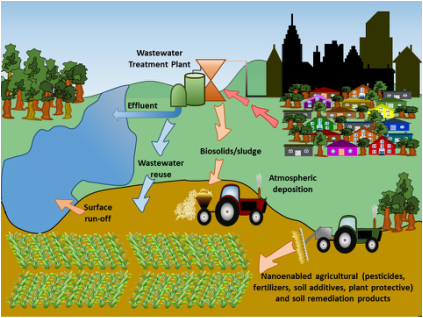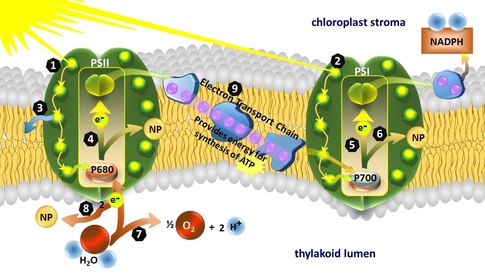Research Projects
 Photo credits: Rico, Cyren M. ProQuest Dissertations and Theses
Photo credits: Rico, Cyren M. ProQuest Dissertations and Theses
Nanoagriculture
The application of ENMs in agricultural practices offers beneficial improvements exceeding those of farm mechanization and green revolution. However, it is a major route in which the environment, food chain and humans may be exposed to ENMs. Nanoformulations are claimed to boost the efficacy of agro-chemicals, improve upon delivery systems, promote plant nutrient uptake and yield, and enhance food quality at minimal impact to the environment. In fact, nano-agricultural inputs (i.e. nanopesticides and nanofertilizers) have been commercially available for several years, and new products are expected to inundate the market if thousands of patent applications currently in the pipeline are approved. As such, it is highly possible that edible plants could be exposed to high levels of ENMs from direct application of nano-enabled agricultural inputs. Alternatively, huge amounts of nanomaterial are expected to reach agricultural fields through applications of biosolids/sludge from wastewater treatment plants. The present state of knowledge in ENMs applications in agriculture is still in a foundational stage. Not only are data limited and inconclusive regarding ENMs impacts in agricultural productivity, nutritional quality and food safety, but more information is needed on properties that control ENMs effects in plants. It is evident that particle size, coating, and surface charge, and application dose and method have influence on ENMs impacts and bioavailability to plants. The interplay of these factors makes it extremely challenging to track and predict nanomaterials impacts in plants. Unlike herbicides and pesticides wherein mechanisms of action can be established based on the functionality of the active ingredients, chemical characteristics that can predict environmental behavior and impacts of nanomaterials are unknown. Hence, plant responses to nanomaterials treatments have been reported but the mechanisms of action are not well-understood. My goal is to understand production, nutrition and safety issues associated with ENMs applications in food crops production. Understanding these complex issues is a critical aspect in gaining public acceptance of nanotechnology and in developing the emerging field of plant nanotechnology. ENMs potential impacts, if not properly understood and managed, could potentially derail the development of a multi-billion dollar nano-agriculture industry.
The application of ENMs in agricultural practices offers beneficial improvements exceeding those of farm mechanization and green revolution. However, it is a major route in which the environment, food chain and humans may be exposed to ENMs. Nanoformulations are claimed to boost the efficacy of agro-chemicals, improve upon delivery systems, promote plant nutrient uptake and yield, and enhance food quality at minimal impact to the environment. In fact, nano-agricultural inputs (i.e. nanopesticides and nanofertilizers) have been commercially available for several years, and new products are expected to inundate the market if thousands of patent applications currently in the pipeline are approved. As such, it is highly possible that edible plants could be exposed to high levels of ENMs from direct application of nano-enabled agricultural inputs. Alternatively, huge amounts of nanomaterial are expected to reach agricultural fields through applications of biosolids/sludge from wastewater treatment plants. The present state of knowledge in ENMs applications in agriculture is still in a foundational stage. Not only are data limited and inconclusive regarding ENMs impacts in agricultural productivity, nutritional quality and food safety, but more information is needed on properties that control ENMs effects in plants. It is evident that particle size, coating, and surface charge, and application dose and method have influence on ENMs impacts and bioavailability to plants. The interplay of these factors makes it extremely challenging to track and predict nanomaterials impacts in plants. Unlike herbicides and pesticides wherein mechanisms of action can be established based on the functionality of the active ingredients, chemical characteristics that can predict environmental behavior and impacts of nanomaterials are unknown. Hence, plant responses to nanomaterials treatments have been reported but the mechanisms of action are not well-understood. My goal is to understand production, nutrition and safety issues associated with ENMs applications in food crops production. Understanding these complex issues is a critical aspect in gaining public acceptance of nanotechnology and in developing the emerging field of plant nanotechnology. ENMs potential impacts, if not properly understood and managed, could potentially derail the development of a multi-billion dollar nano-agriculture industry.
 Photo credits: Rico et al. in Siddiqui et al. (eds.) Springer 2015, DOI;10.1007/978/-3-319-14502-0_1
Photo credits: Rico et al. in Siddiqui et al. (eds.) Springer 2015, DOI;10.1007/978/-3-319-14502-0_1
Determining sensitive endpoints and developing analytical techniques for plant-ENMs exposure studies.
The last 10 years of active nanophytotoxicity studies have revealed much understanding on ENMs impacts in terrestrial organisms. However, literature review would show that endpoints used (germination, biomass, pigment production) are rather insensitive for elucidating mechanisms of action of toxicity. The research community should now work on determining subtle systems-level processes that can be used as more relevant tools for predicting environmental toxicity of ENMs.
The last 10 years of active nanophytotoxicity studies have revealed much understanding on ENMs impacts in terrestrial organisms. However, literature review would show that endpoints used (germination, biomass, pigment production) are rather insensitive for elucidating mechanisms of action of toxicity. The research community should now work on determining subtle systems-level processes that can be used as more relevant tools for predicting environmental toxicity of ENMs.

